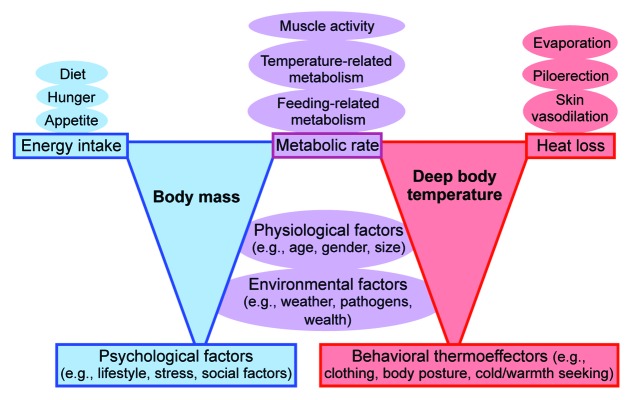Despite smaller physiological variations (circadian changes, ovulatory cycle, exercise, etc.), deep body temperature is relatively stable (depending on species) due to regulatory processes (Fig. 1). Core temperature is one of the components of milieu intérieur, similarly to other components it contributes to the stability of physiological functions. The basic physiological regulation is determined by a balance between the actual metabolic rate (heat production) and commensurate heat loss.1 In addition to continuous but varying basal metabolism of tissues, induced heat production (temperature- and feeding-related metabolism and muscle activity) can contribute to excess heat generation in cases of increased heat loss (e.g., cold exposure) or when core temperature has to be elevated (e.g., fever). The actual forms of heat loss (radiant, evaporative, convective/conductive) depend on the environment and the overall condition of the organism. Apart from physiological regulation, behavioral thermoregulation is also used—in fact in humans this is the preferred way of thermoregulation, because these mechanisms impact the body's energy and water resources to a smaller extent than the autonomic effectors.2 Other physiological factors (age, gender, body size, etc.) as well as environmental ones (weather, pathogens, wealth, etc.) also influence these regulations.
Figure 1. Body temperature: Its regulation in framework of energy balance.
However, metabolic rate does not only depend on thermoregulatory processes. It always entails utilization of those energy-containing substances that originate from nutrients of the food. Thus, energy intake by feeding has to be balanced with energy expenditure, in order to maintain the energy content of the body (body mass) at a standard level. Food intake is also regulated: hunger, appetite, and composition of the diet are the most important influencing factors. Psychological and environmental/physiological factors also contribute to body mass regulation, similarly as to the regulation of temperature. Factors of the complex energy balance are in interaction.
Cold exposure enhances heat loss and induces compensatory rise in metabolic rate and food intake (although the latter may not be sufficient to maintain normal body mass). Hot environment enhances heat loss and suppresses food intake.
Under thermoneutral conditions, severe primary elevation of metabolic rate (exercise, hyperthyroidism) not only modifies thermoregulation and heat loss but also leads to hyperphagia.
In turn, changes in food intake may affect thermoregulation. Starvation results in suppression of resting metabolic rate and different severity of hypothermia.3 Disproportionally high food intake may lead to obesity without affecting core temperature but burdening heat loss effectors.
Components of the system may be affected independently, particularly in pathological conditions. In sickness behavior, e.g., fever and anorexia are characteristic.4 Another example is the increased sweating induced by adrenergic hyperactivity.
In conclusion, regulation of complex energy balance involves maintenance of body mass and body temperature. Effectors and influencing factors of their regulatory mechanisms and circles are in interaction, although the components can also function independently.
Teaching Slide
The PowerPoint version of this Teaching Slide can be downloaded from the Supplemental Material.
Disclosure of Potential Conflicts of Interest
No potential conflicts of interest were disclosed.
Supplemental Materials
Supplemental materials may be found here: http://www.landesbioscience.com/journals/temperature/article/29060/
References
- 1.Székely M, et al. . Curr Protein Pept Sci 2005; 6:327 - 53; http://dx.doi.org/ 10.2174/1389203054546343; PMID: 16101437 [DOI] [PubMed] [Google Scholar]
- 2.Romanovsky AA. . Am J Physiol Regul Integr Comp Physiol 2007; 292:R37 - 46; http://dx.doi.org/ 10.1152/ajpregu.00668.2006; PMID: 17008453 [DOI] [PubMed] [Google Scholar]
- 3.Garami A, et al. . Eur J Pharmacol 2010; 644:61 - 6; http://dx.doi.org/ 10.1016/j.ejphar.2010.07.002; PMID: 20637192 [DOI] [PubMed] [Google Scholar]
- 4.Szelényi Z, et al. . Front Biosci 2004; 9:2447 - 56; http://dx.doi.org/ 10.2741/1406; PMID: 15353297 [DOI] [PubMed] [Google Scholar]
Associated Data
This section collects any data citations, data availability statements, or supplementary materials included in this article.



